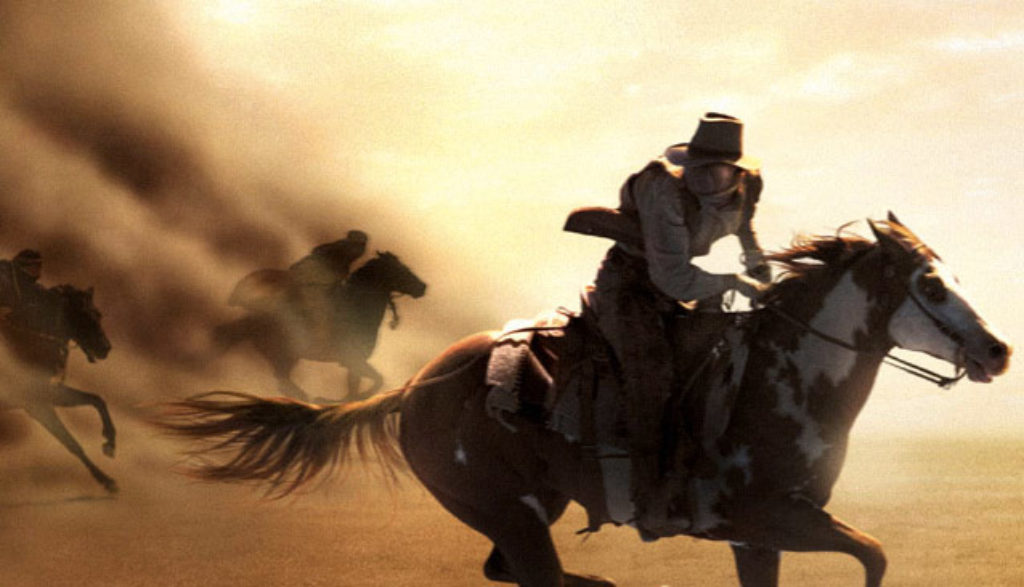
Hidalgo is an 1890s adventure yarn based loosely on the life of long-distance horse racer Frank T. Hopkins and his faithful companion, a sorrel-and-white Spanish mustang who looks like he just galloped off a Bev Doolittle painting. It’s also Viggo Mortensen’s first star turn since bursting into cultural consciousness in The Lord of the Rings. The screenplay was written by John Fusco, who also gave us Thunderheart and Spirit: Stallion of the Cimarron.
Frank (part Sioux Indian, part white) experiences a crisis after rushing orders to American soldiers who proceed to massacre a peaceful group of Indians at Wounded Knee. Eight months later we see this drunken shell of a man riding for a wild west show. That’s where he’s challenged by a Bedouin sheikh to take part in the Ocean of Fire, a dangerous 3,000-mile race across the Arabian Desert. Frank rides his steed Hidalgo through blistering heat and sandstorms against the finest-bred stallions in the East, pausing only to rescue the sheikh’s daughter from her villainous cousin and defend himself against scheming fellow riders.
Although violent when provoked, Frank is a quiet, respectful gentleman. His chivalry and honor include being kind to rivals who berate him, refusing the advances of a married woman, and rescuing a princess from vicious thieves. At one point he saves a horse and rider from certain death, noting, “Ain’t no prize money worth a man’s life.”
Frank’s friends pitch in the money he needs to participate in the big race. Frank buys a young slave to insure he will be treated with respect, and generously purchases the freedom of many wild mustangs slated for destruction. The Arab sheikh develops respect for Frank and sacrificially extends his hand in friendship. His culture’s chauvinistic attitude towards women is meant to appear outdated and inappropriate. The princess aids Frank, partly out of kindness and partly to help him beat the rider who wants to, in victory, make her his fifth wife. A noble warrior gives his life for the princess, who mourns him (“He pledged his life for me when I was born worthless”). A man is vilified for being a traitor. Frank refuses to take a bribe—or a dive.
Hidalgo shows bravery and perseverance amidst pain. He and Frank share a friendship deeper than many human relationships, and they make sacrifices for one another. (Five horses were used in the title role. Mortensen so bonded with the primary equine star, T.J., that he now owns the animal.)
The Sioux at Wounded Knee are members of the Ghost Dance Religion, a phenomenon that took hold in the late 1880s after a Paiute holy man, Wovoka, built a faith out of his father’s teachings and his own visions during a solar eclipse. The Ghost Dance Religion claimed that the earth would soon perish and be resurrected in a pure state, and be inherited by Indians both living and dead. There they would live forever free from suffering. This required clean, honest, harmonious living apart from the white man’s ways. Indians in the film are shown dancing and chanting. Through those dances, it is said participants could die briefly and glimpse the coming paradise.
Frank’s Muslim hosts in Iraq and Syria constantly invoke the name of Allah. They talk of trusting in and praying to Allah, and treat Frank as a Western infidel. The sheikh welcomes Frank into his tent (“in the name of Allah”), but won’t shake his hand because he believes touching an unclean white man will cost him his ability to foresee the future (later the ruler questions whether or not he ever had the gift of prophecy to begin with). Furthermore, the sheikh says, “Our culture revolves around our sacred horses. It is written in the Quran.” Others echo his claim that the horse is a “sacred” animal. An Arab talks about a Sun Devil. Another tells Frank his soul will go straight to the devil. A trapped rider tells Frank to leave him to die because it is “Allah’s will.”
The Indian chief calls Frank “Far Rider” because he is lacking inner peace and has chosen to ride far from himself. The princess tells Hopkins not to hide “who God made you.” At her suggestion, Frank considers a swarm of locusts “a gift from above, not a plague.” Immediately after Mrs. Davenport tips her scheming hand, she is referred to as “the Christian lady” (more a reference to her European heritage than any profession of faith, but the timing of the remark could be interpreted as a smear).
Early on, Frank puts more faith in his .45 caliber bullets than in the Creator, saying, “God didn’t make all men equal; Mr. Colt did.” Later he refuses to accept the notion of God’s will superceding the desire and perseverance of an individual competitor (“What about your will? What about your horse’s will?”) to finish the race. [Spoiler Warning] Ready to put Hidalgo down, Frank stops when he hears Indian chants and sees visions. He begins chanting in his Native American tongue, gets advice from a mirage and gains the strength to finish the race by finally embracing his Sioux roots.
Mrs. Davenport comes on to Frank, who politely walks away from her indecent proposal. A misunderstanding occurs when Frank throws himself on the princess in order to protect her from harm, only to be accused of sexual misconduct (punishment for the crime is castration). Frank advises Hidalgo to avoid the mares (“Keep your pride tied”). The evil nephew challenges his uncle’s manhood by doubting the sheikh’s ability to have an erection.
The actual battle of Wounded Knee (Dec. 29, 1890) lasted less than an hour, but left 150 Indians dead and 50 hurting. Army casualties were fewer, but 25 soldiers lost their lives and 39 were injured. Onscreen, we mainly see soldiers firing on Indians. The film’s depiction of how that conflict began is consistent with the historical record: Soldiers were ordered to disarm the Sioux and panicked when a deaf brave named Black Coyote failed to heed the order. A shot rang out, sparking a brutal exchange.
When a man picks a fight with Frank in a bar, Frank decks him with a single punch. Horses throw their riders. Frequent action violence finds people shot, stabbed, beheaded, impaled and threatened with mutilation. People use knives and guns to make violent threats. Frank has a dream in which Buffalo Bill Cody casually picks off natives with a pistol (Cody and his wild west show exploit Indians and romanticize the Wounded Knee massacre to make the Indians appear evil and the cavalry look good). An Arabian rider finishes off his injured horse by plunging a dagger into the beast. Frank fights with a bunch of guys abusing Hidalgo, and takes a shovel to the face. A teepee is set on fire. A winged predator kills a small rabbit. A desperate quest for water leads Frank to punch a belligerent Brit. Leopards attack a man (screams are heard, but the visuals aren’t graphic).
A half-dozen mild profanities (mainly “h—” and “d–n”).
Frank and other men drink at a bar. Others consume whiskey on a train. In the months following Wounded Knee, Frank becomes a drunkard, using alcohol to drown out the indignity of performing in a traveling wild west show. He smokes hand-rolled cigarettes. He and Major Davenport drink gin. The sheikh smokes a pipe.
Men play poker. There’s also heavy wagering on the cross-country horse race. Through most of the film, Frank shows mercy to his enemies, but one huge exception is when he has the chance to either rescue or kill his main tormenter.
Although the depiction of the terrible massacre at Wounded Knee isn’t blatantly revisionist, the omission of certain facts tend to vilify the U.S. Army without noting the potential threat against them. The filmmakers neglect to mention that, before the violence broke out that day, Sioux mystics including Short Bull and Yellow Bird opposed the anti-violence stance of their peer, Wovoka, and had actually advocated resistance and the elimination of the white man. They believed their Ghost Dance shirts would protect them from the white man’s bullets. Did the soldiers overreact and unnecessarily slaughter women and children in the process? Absolutely. But the film’s suggestion that the Indians were simply peaceable earth-worshippers is illustrative of the film’s myopic treatment of history.
On the whole, there seems to be an agenda at work: Native horse cultures, good; white man, bad. There’s nary a sympathetic white European in the entire film. They’re all depicted as greedy infidels intent on mistreating natives and raping the landscape. Even Frank doesn’t achieve redemption until the end of the story when he fully embraces his Sioux side.
Hidalgo is an enjoyable period adventure that gives viewers an incorruptible protagonist to root for—a throwback to westerns from the 1940s and ’50s. Being able to identify with the more noble qualities of Frank Hopkins makes slogging across hot sand for over two hours a little more interesting. Whether or not he wins the race, his greater struggle is preserving his decency and humanity in the face of malicious abuse and discrimination. We root—rightfully—for him to succeed. The lack of sex and profanity is also refreshing.
Hidalgo transitions from historical epic to action film when the Bedouin raiders kidnap the sheikh’s daughter. That triggers an eruption of Indiana Jones-style violence too intense for young viewers. An even bigger sticking point for some families will be the sheer volume of Indian and Muslim spirituality woven into the story. Both can be navigated by mature audiences, though fans of escapist entertainment may not like their popcorn flicks liberally sprinkled with PC proselytization.

Our weekly newsletter will keep you in the loop on the biggest things happening in entertainment and technology. Sign up today, and we’ll send you a chapter from the new Plugged In book, Becoming a Screen-Savvy Family, that focuses on how to implement a “screentime reset” in your family!